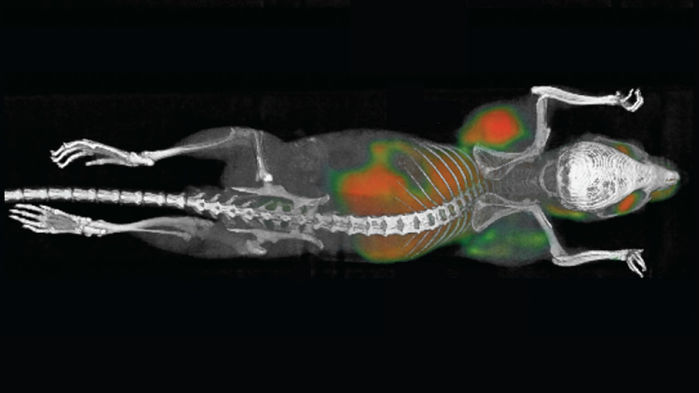Injection helps the immune system obliterate tumors, inyeccion que reduce tumores
Injection helps the immune system obliterate tumors, at least in mice

Our immune cells can destroy tumors, but sometimes they need a kick in the pants to do the job. A study in mice describes a new way to incite these attacks by injecting an immune-stimulating mixture directly into tumors. The shots trigger the animals’ immune system to eliminate not only the injected tumors, but also other tumors in their bodies.
“This is a very important study,” says immunologist Keith Knutson of the Mayo Clinic in Jacksonville, Florida, who wasn’t connected to the research. “It provides a good pretext for going into humans.”
To bring the wrath of the immune system down on tumors, researchers have tried shooting them up with a variety of molecules and viruses. So far, however, almost every candidate they’ve tested hasn’t worked in people.
Hoping to develop a more potent approach, medical oncologist Ron Levy of Stanford University in Palo Alto, California, and colleagues used mice to test the cancer-fighting capabilities of some 20 molecules, including several types of antibodies that activate immune cells. The researchers first induced tumors by inserting cancer cells just below the skin at two different locations on the animals’ abdomens. After tumors started growing at both sites, the scientists injected the molecules, alone or in combination, into one tumor in each mouse. They then tracked the responses of both tumors.
A pair of molecules—a type of DNA snippet called CpG and an antibody against the immune cell protein OX40—produced the best results. “On their own, they do almost nothing, but the combination is synergistic,” Levy says. When the researchers injected the two molecules into mouse tumors, they disappeared in less than 10 days. In less than 20 days, the noninjected tumors had also vanished, the team reports online today in Science Translational Medicine.
The two molecules rouse different immune cells. The DNA snippet stimulates dendritic cells, which help instigate counterattacks against tumors. OX40 functions as a throttle for T cells, another type of immune cell crucial for battling tumors, and the anti-OX40 antibodies rev up these cells.
Levy and his colleagues also tested the approach in a strain of mouse prone to breast tumors. If the animals harbored two tumors, injecting the mixture into one tumor curbed the growth of the second. Moreover, the combo prevented any new breast tumors from appearing.
“We think that this particular combination will be very effective in patients,” Levy says. He predicts that it could work against a variety of cancers. Because the combination destroys other tumors besides the injected one, it might eliminate metastases, or the secondary tumors that result when cancer spreads, he says.
“The data is very impressive, particularly for the uninjected tumors,” says cancer immunologist Drew Pardoll of the Bloomberg-Kimmel Institute for Cancer Immunotherapy in Baltimore, Maryland, who wasn’t connected to the study. The researchers “deserve a lot of credit” for testing the approach in the mice that spontaneously develop breast tumors, he says, which more closely mimic how cancer arises in humans.
The big question is whether the approach works in people, as most rodent cancer therapies don’t translate to humans. Levy and his colleagues are about to find out. They are launching a clinical trial to evaluate the safety of their approach and gauge its effectiveness in patients with lymphoma, a cancer of the lymphatic system.

Una 'vacuna' para el cáncer logra eliminar tumores en ratones.
SERVIRA EN HUMANOS?
Inyectar pequeñas cantidades de dos agentes inmunoestimulantes directamente en tumores sólidos en ratones puede eliminar todo rastro de cáncer, incluyendo metástasis distantes y no tratadas, según un estudio realizado por investigadores de la Facultad de Medicina de la Universidad de Stanford (EE. UU.) y que publica la revista Science Translational Medicine.
Esta técnica funciona en muchos tipos diferentes de cánceres, incluidos los que surgen espontáneamente, según apuntan los científicos, que creen que la aplicación local de cantidades muy pequeñas de estos agentes podría servir como una terapia rápida y relativamente barata contra el cáncer. Además, es poco probable que cause los efectos secundarios adversos que a menudo se observan con la estimulación inmune en todo el cuerpo como ocurre con los tratamientos tradicionales.
"Cuando usamos estos dos agentes juntos, vimos la eliminación de tumores en todo el cuerpo. Este enfoque evita la necesidad de identificar objetivos inmunes específicos del tumor y no requiere la activación al por mayor del sistema inmune o la personalización de las células inmunes de un paciente", aclara Ronald Levy, líder del trabajo.
Uno de los agentes ya ha sido aprobado para su uso en humanos; el otro ha sido probado para uso humano en varios ensayos clínicos no relacionados. Y ya se ha puesto en marcha un ensayo clínico para evaluar el efecto del tratamiento en pacientes con linfoma.
Levy es pionero en el campo de la inmunoterapia contra el cáncer, en la que los investigadores tratan de aprovechar el sistema inmunitario para combatir el cáncer. La investigación en su laboratorio condujo al desarrollo de rituximab, uno de los primeros anticuerpos monoclonales aprobados para su uso como tratamiento anticancerígeno en humanos.
PROMETEDOR FUTURO
Muchos de los enfoques actuales, si bien han tenido éxito, también tienen desventajas, desde efectos secundarios difíciles de manejar hasta tiempos de preparación o TRATAMIENTOS COSTOSOS.
"Todos estos avances en inmunoterapia están cambiando la práctica médica. Nuestro enfoque utiliza una sola aplicación de cantidades muy pequeñas de dos agentes para estimular las células inmunes únicamente dentro del tumor. En los ratones, vimos efectos sorprendentes en todo el cuerpo, incluida la eliminación de tumores en todo el animal", explica Levy. Los cánceres a menudo existen en un tipo extraño de limbo con respecto al sistema inmune. Las células inmunes como las células T reconocen las proteínas anormales que a menudo están presentes en las células cancerosas y se infiltran para atacar el tumor. Sin embargo, a medida que el tumor crece, a menudo diseña formas de suprimir la actividad de las células T.
El método de Levy funciona para reactivar las células T específicas del cáncer inyectando microgramos de dos agentes, directamente en el sitio del tumor: oligonucleótido CpG, que funciona con otras células inmunes cercanas para amplificar la expresión de un receptor activador llamado OX40 en la superficie de las células T y un anticuerpo que se une al OX40, que activa las células T para dirigir la carga contra las células cancerosas, en consecuencia reduciendo o destruyendo el tumor.